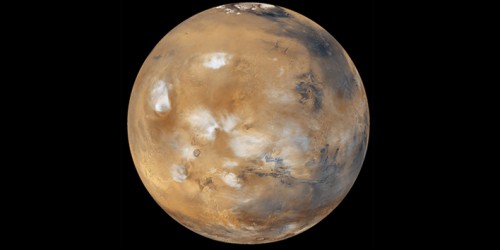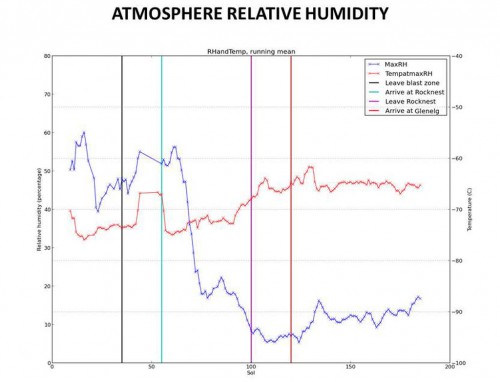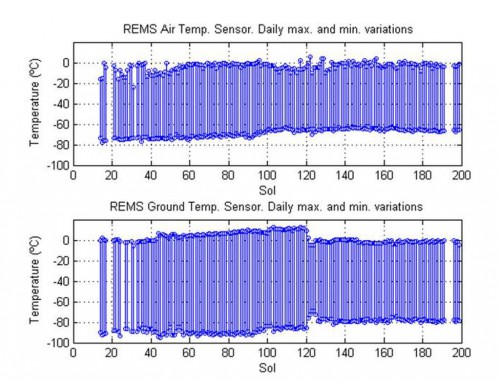
For any future astronauts who land on Mars, there is one piece of advice that shouldn’t even need to be said: keep your helmet on! Mars has an atmosphere, like Earth, but it is much thinner than ours (and mostly carbon dioxide), and so is unbreathable by humans. However, evidence has continued to grow that Mars’ atmosphere was once a lot thicker than it is now, early on in the planet’s history. Recent findings from the Curiosity rover have added to that evidence, as well as showing not only how Mars has lost most of the atmosphere that it once had, but also that the atmosphere which remains is still very active.
The new data was presented last Monday at the European Geosciences Union 2013 General Assembly in Vienna.
Most of Mars’ original atmosphere has leaked into space, a process that previous evidence has indicated, but is now also supported by analysis from the Sample Analysis at Mars (SAM) instrument on Curiosity. SAM has made very precise measurements of argon isotopes in the Martian atmosphere; these isotopes are variants of the same argon molecule which have different atomic weights. Currently, the atmosphere contains four times the amount of a lighter stable isotope (argon-36) than a heavier one (argon-38). The original ratio of argon in the early solar system was much higher than it is now, so the lower ratio on Mars indicates that most of the lighter argon isotope has been lost over time.
“We found arguably the clearest and most robust signature of atmospheric loss on Mars,” said Sushil Atreya, a SAM co-investigator at the University of Michigan, Ann Arbor.

Despite the atmosphere now being much thinner, Curiosity has found that it is still quite dynamic. Measurements have shown differing humidity in various locations along the path that the rover has traveled so far. The daily air temperature has also gradually climbed since when Curiosity first landed last August, as winter has turned into spring and then summer. The daily highs have been up to about 0˚C (34 ˚F) and the lows about -70 ˚C (-94 ˚F). While plunging at night and in winter, daytime temperatures, especially in the summer, can be relatively comfortable by earthly standards.

Of course, it has already been long known that the Martian atmosphere, despite now being so much less dense than Earth’s, can still put on a good show. Strong winds can create global dust storms. Huge dust devils leave their tracks on the ground and have been photographed in action by the Spirit and Opportunity rovers. Smaller whirlwinds have also been detected by Curiosity, although they didn’t raise enough dust to be seen directly. The Phoenix lander also observed snow falling over its landing site near the north pole, fog has been seen in canyons and wispy clouds have been seen both from orbit and from the ground.
Thanks to these and other observations by various orbiters, landers, and rovers, we now have a much better idea of what Mars used to be like—a world with a much thicker atmosphere, rain, rivers, lakes, and maybe even oceans. A lot has changed since then, but at least in terms of its atmosphere, the Red Planet is still very much alive.
Want to keep up-to-date with all things space? Be sure to “Like” AmericaSpace on Facebook and follow us on Twitter:@AmericaSpace




Anyone…Is there enough wind to power a windmill and generate electricity?
That’s an awesome idea, Tracy 😀
Mars Curiosity has recorded average wind speeds on Mars from around 50-70 mph, and a maximum of +100 mph. The current strongest wind turbines in use can handle speeds of 161 mph. So these would be able to handle Mars’ winds 😀
Though then the constructional factors must be addressed, like:
– the difference in gravity (62% less on Mars than on Earth), which could affect how the moving parts on the turbine affects the entire turbine structure.
– the high amounts of dust in the Martian air, which could get inside the mobile parts of the turbine and damage/jam the mechanisms.
– the stability and strength of the Martian soil. It could pose problems to the setting up of the turbine in the terrain, which may not be sufficient in holding such a large piece of machinery. This may actually be equilibrated by the low gravity, nonetheless, it’s important.
I’m sure you could get some energy but it would never amount to the energy cost of putting the windmill up in the first place.
Ken, does that really matter, though? If the aim is to establish sustainable forms of living on Mars, then wouldn’t using windmills to convert wind energy be beneficial, despite the overall loss of energy? The main idea behind future colonization on Mars is that colonies would be able to sustain itself in the long run with minimal rocket trips from Earth, so windmills could be a great option.
Yes, it matters because the amount of energy per unit mass matters and by that measure just about everything beats windmills on mars.
Great,
Or maybe it could be Manufactured on Mars with 3D printers….or “the replicator”…
Thanks for that nice article, Paul. It is notable that daytime ground temperatures are above the air temperatures. Eyeballing the ground temperature plot, I estimate the highest ground temperature reached as about 15 C, about 60 F. Depending on the amount of water vapor in the air near the surface this could allow small amounts of water to condense to liquid for short periods.
Bob Clark
Windmills,,,,solar cells,,,nuclear,,,anything and everything.
Fires in order to make smoke to make clouds to deflect part of the hard radiation….
If I had a choice of what to send to Mars it would be a Drilling Rig,,,,,with rock bits to go at least 100 meters deep…. with tools on mars to analyze the cores (cuttings)…and the salinity plus acidity of the water found….also seismograph or whatever it takes (ground radar) to
determine if habitability underground is an option.
Second would be a Human rated,,Habitat.
Observe,,,the one thing will never change is the
62% gravity…this puts things very high in our favor..
Observe,,,a rover (or whatever else) built to Earth gravity specs,,,becomes almost invulnerable in a lighter Gravity.
Observe,,,the time to Terraform is NOW.
Yes,,,very Good,,,,,3/D printers are still evolving,,
think robotic smelters on Mars,,,,,Thank goodness
the USA got off its butt and has started making more 238.
Mars is literally a metal surface planet,,,,,the red you see is rust…a goldmine of metals for your 3/D printer,,,
Now if we could come up with something that would burn and make clouds and also a bit of oxygen as
a by-product?
Come on,,,smart people ,,Give me an answer.
jd